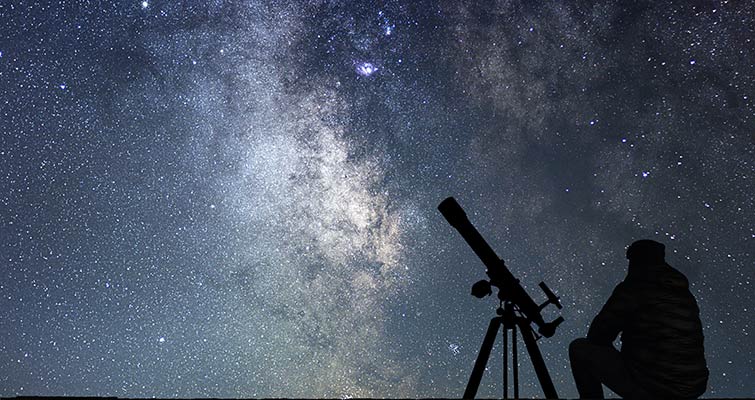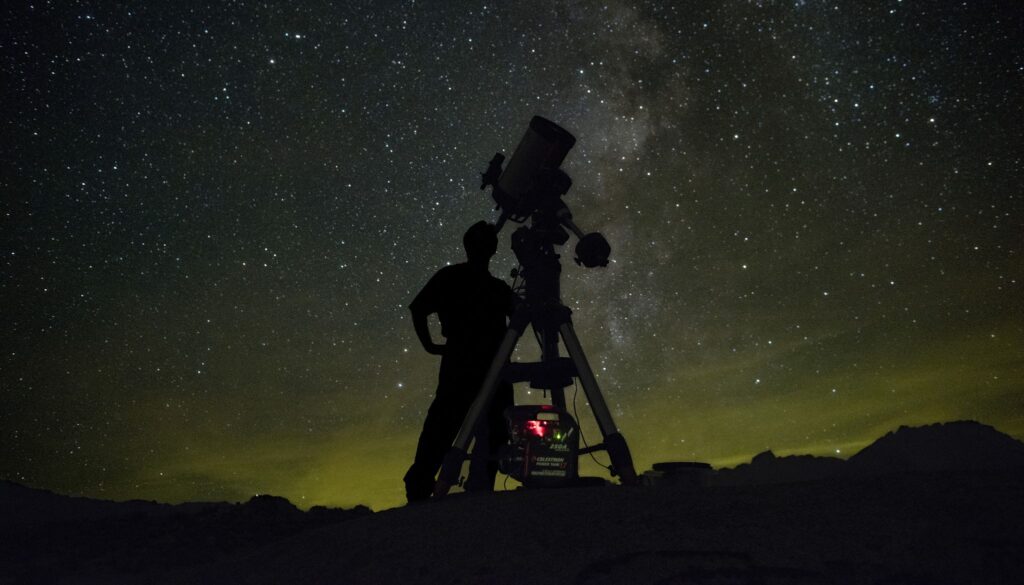To learn astronomy as a beginner, start by exploring the night sky. Look for constellations and bright stars with your naked eye or use astronomy apps and websites for guidance. Learn about celestial objects like planets, stars, and galaxies, and understand the basics of the solar system.
Get familiar with tools like binoculars and telescopes, and use star charts to locate objects. Practice observing techniques, such as finding dark-sky locations and using telescopes properly. Utilize resources like books, online courses, and astronomy clubs to deepen your knowledge.
Remember to be patient, join a community, and set achievable goals as you embark on your astronomy journey.
How can beginners start exploring the night sky?

Beginners can start exploring the night sky by simply stepping outside and looking up. To get started, find a location away from bright city lights, such as a park or rural area, where the night sky is clearer and the stars shine more brightly.
Once you’re in a suitable spot, take a moment to let your eyes adjust to the darkness. Then, look for recognizable patterns of stars known as constellations. Some of the easiest constellations to spot include Orion, with its distinctive belt of three stars, the Big Dipper, a part of the larger constellation Ursa Major, and Cassiopeia, which resembles a “W” or “M” depending on its orientation in the sky.
To help identify stars and planets, consider using a stargazing app or website. These tools can provide real-time information about the celestial objects visible in your area and help you navigate the night sky more effectively.
For a closer look at celestial objects, especially distant stars and galaxies, you may want to invest in a pair of binoculars. While not as powerful as telescopes, binoculars can enhance your stargazing experience and reveal more detail than the naked eye alone.
Additionally, joining a local astronomy club or taking an introductory astronomy course can provide valuable guidance and support as you begin your journey into exploring the night sky. These resources often offer star parties, workshops, and observing sessions led by experienced astronomers, allowing you to learn from their expertise and connect with fellow stargazers.
What are some basic celestial objects beginners should know about?

For beginners in astronomy, it’s helpful to start by familiarizing yourself with some basic celestial objects. Here are a few key ones to know about
Stars
These are the bright, glowing objects we see in the night sky. They vary in size, temperature, and color. Some famous stars include Sirius, the brightest star in the night sky, and Betelgeuse, a red supergiant in the constellation Orion.
Planets
Planets are celestial bodies that orbit around stars. In our solar system, there are eight planets, including Mercury, Venus, Earth, Mars, Jupiter, Saturn, Uranus, and Neptune. They range in size and composition, and some, like Jupiter and Saturn, are known for their distinctive rings.
The Moon: Earth’s natural satellite, the Moon, is a familiar sight in the night sky. It goes through phases, from full moon to new moon and everything in between, as it orbits around Earth.
Galaxies
Galaxies are vast collections of stars, gas, and dust held together by gravity. The Milky Way, our home galaxy, contains billions of stars and is just one of many galaxies in the universe.
Constellations
Constellations are patterns of stars that form recognizable shapes or figures in the sky. They have been used for thousands of years as a way to navigate and tell stories about the cosmos. Some well-known constellations include Orion, Ursa Major (home to the Big Dipper), and Cassiopeia.
Nebulae
Nebulae are clouds of gas and dust in space where new stars are born. They come in various shapes and colors and are often visible as faint, fuzzy patches in the night sky.
What tools and equipment do beginner astronomers need?
Beginner astronomers need basic tools like binoculars and telescopes to observe celestial objects, while star charts and planispheres help them navigate the night sky.
Additionally, keeping a journal helps beginners record their observations and track their progress as they explore the wonders of astronomy
Binoculars and Telescopes
Binoculars are an excellent starting point for beginner astronomers. They offer a wider field of view compared to telescopes, making them great for observing large celestial objects like star clusters and the Moon. Look for binoculars with a moderate magnification (7x to 10x) and a wide objective lens diameter (at least 50mm) for better light-gathering capabilities.
While not essential for beginners, telescopes can provide more detailed views of celestial objects. There are various types of telescopes available, including refractor, reflector, and compound telescopes. For beginners, a Dobsonian telescope is often recommended for its ease of use and affordability. Consider factors such as aperture size, focal length, and portability when choosing a telescope.
Star Charts and Planispheres
Star charts are maps of the night sky that show the positions of stars, constellations, and other celestial objects. They can be printed or digital and are essential for navigating the night sky. Beginners can start with simple star charts that highlight prominent constellations and bright stars visible to the naked eye.
Planispheres are handy tools for identifying stars and constellations at any time of the year. They consist of a rotating disk that displays the stars visible in the night sky for a specific date and time. Beginners can use planispheres to learn how the positions of stars and constellations change throughout the night and across the seasons.
Recommended Resources for Beginners
Books: There are many beginner-friendly books on astronomy available, covering topics ranging from stargazing basics to the science behind celestial phenomena. Look for titles written by reputable astronomers or organizations like NASA and the Royal Astronomical Society.
Online Courses: Online courses offer a flexible and convenient way for beginners to learn about astronomy from the comfort of their own home. Websites like Coursera, Udemy, and Khan Academy offer introductory courses taught by experienced astronomers and educators.
Astronomy Clubs and Organizations: Joining a local astronomy club or organization can provide valuable guidance, support, and opportunities for hands-on learning. Many clubs host star parties, workshops, and observing sessions where beginners can interact with experienced astronomers and observe the night sky through telescopes.
Some tips for beginners to observe the night sky effectively

For beginners to observe the night sky effectively, find a dark-sky location away from city lights, use a red flashlight to preserve night vision, and start with simple constellations. Additionally, practice patience and take your time to let your eyes adjust to the darkness for better stargazing experiences. Let’s take a deeper look
Finding a Dark-Sky Location
Finding a dark-sky location is essential for optimal stargazing conditions. Light pollution from cities and urban areas can significantly reduce visibility and obscure faint celestial objects. Look for locations far away from artificial lights, such as national parks, rural areas, or designated dark-sky preserves, where the night sky is less affected by light pollution.
Use dark-sky apps and maps to locate areas with minimal light pollution near you. These tools provide information about light pollution levels, moon phases, and celestial events, helping you plan your stargazing outings more effectively.
When stargazing in remote locations, prioritize safety by informing someone of your plans, bringing adequate supplies (such as water, snacks, and warm clothing), and being aware of potential hazards like wildlife or uneven terrain.
Using a Telescope Properly:
Properly setting up and aligning your telescope is crucial for getting clear and accurate views of celestial objects. Follow the manufacturer’s instructions carefully and ensure that your telescope is stable and securely mounted on a tripod or equatorial mount.
Adjust the focus of your telescope to achieve sharp and detailed views of celestial objects. Start with low magnification eyepieces to locate objects easily, then gradually increase magnification for closer views. Avoid using excessive magnification, as it can result in dim and blurry images.
Many telescopes come with motorized mounts or tracking systems that automatically follow the motion of celestial objects as they appear to move across the sky. Take advantage of these features to keep objects centered in your telescope’s field of view for extended observation sessions.
Recording Observations and Keeping a Journal
Recording your observations and experiences in a journal can enhance your stargazing journey by helping you track your progress, reflect on your observations, and identify patterns or trends in celestial events. It also serves as a valuable reference for future observations.
Include details such as the date, time, location, and weather conditions of your observations, as well as the objects you observed and any notable observations or discoveries you made. Use sketches, diagrams, or photographs to document what you see.
Take time to review your journal regularly and reflect on your observations. Note any trends or changes in celestial phenomena over time, and use your journal as a tool for learning and improvement in your stargazing skills.
FAQ
Is astronomy difficult to study?
Astronomy can be challenging due to its complex concepts and the significant role of mathematics and physics. However, with dedication and the right strategies, it is a deeply rewarding scientific field1.
Is astronomy a lot of math?
Yes, astronomy involves a significant amount of math. Concepts such as calculus, statistics, and differential geometry are essential for understanding celestial phenomena and analyzing data23.
Is astronomy a good career?
Astronomy can be a promising career for those interested in studying the universe. It offers varied opportunities in research, education, and applied sciences. Astronomers have outstanding salaries and excellent job satisfaction45.
Which subject is best for astronomy?
To pursue a career in astronomy, a strong foundation in physics and mathematics is crucial. Relevant subjects include physics, math, computer science, and earth and space science6.
Can I take astronomy without physics?
While some support positions in astronomy may be open to those with Bachelor’s or Master’s degrees without a physics background, most research positions and professorships require a solid foundation in physics and mathematics7.
What kind of math is needed for astronomy?
Astronomers use various mathematical tools, including
- Trigonometry
- Conics
- Differential and integral calculus
- Differential geometry
- Statistics and probabilities
Final thoughts
Beginners can start learning astronomy by exploring the night sky, using tools like binoculars and telescopes, and accessing resources such as books and online courses.
Remember to find dark-sky locations for better visibility, properly use telescopes for clear views, and keep a journal to record observations and track progress.
With patience and practice, beginners can enjoy the wonders of the cosmos and embark on a rewarding journey of discovery.
